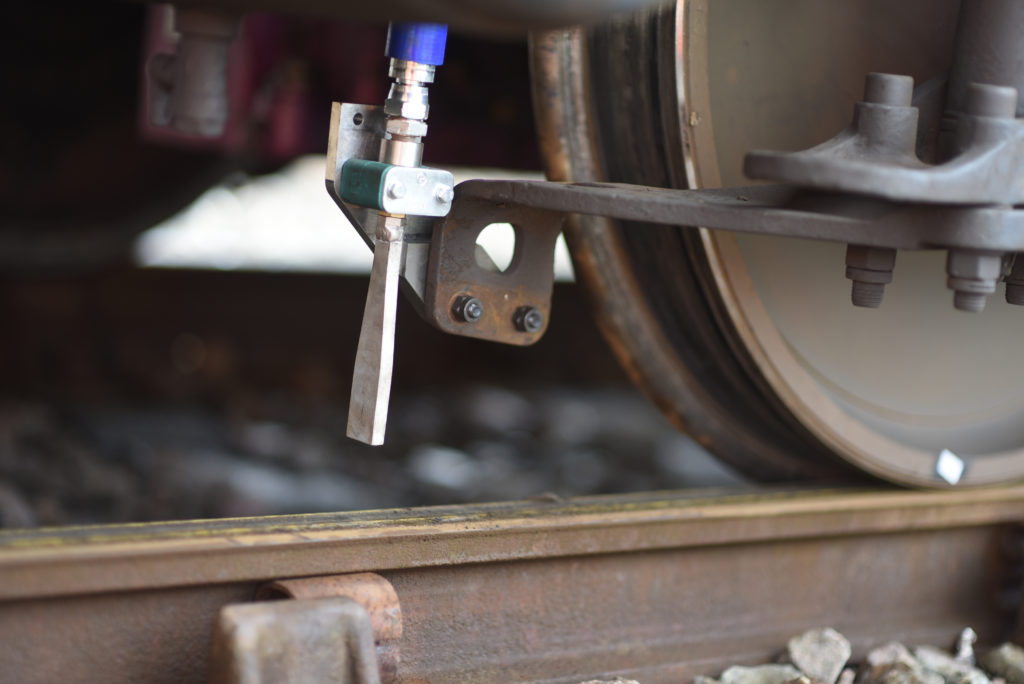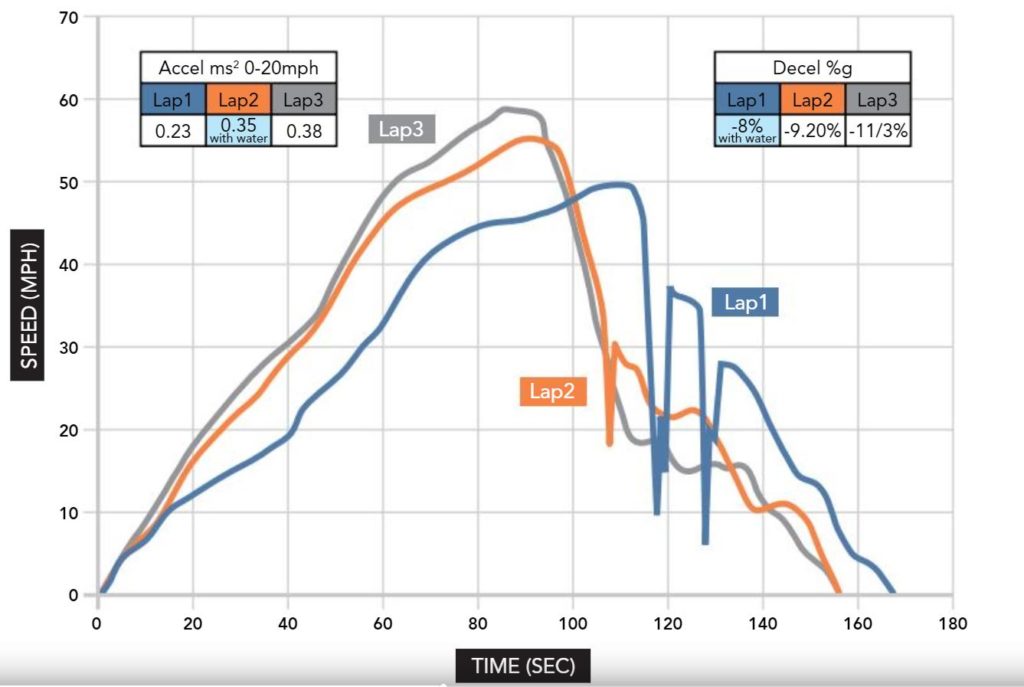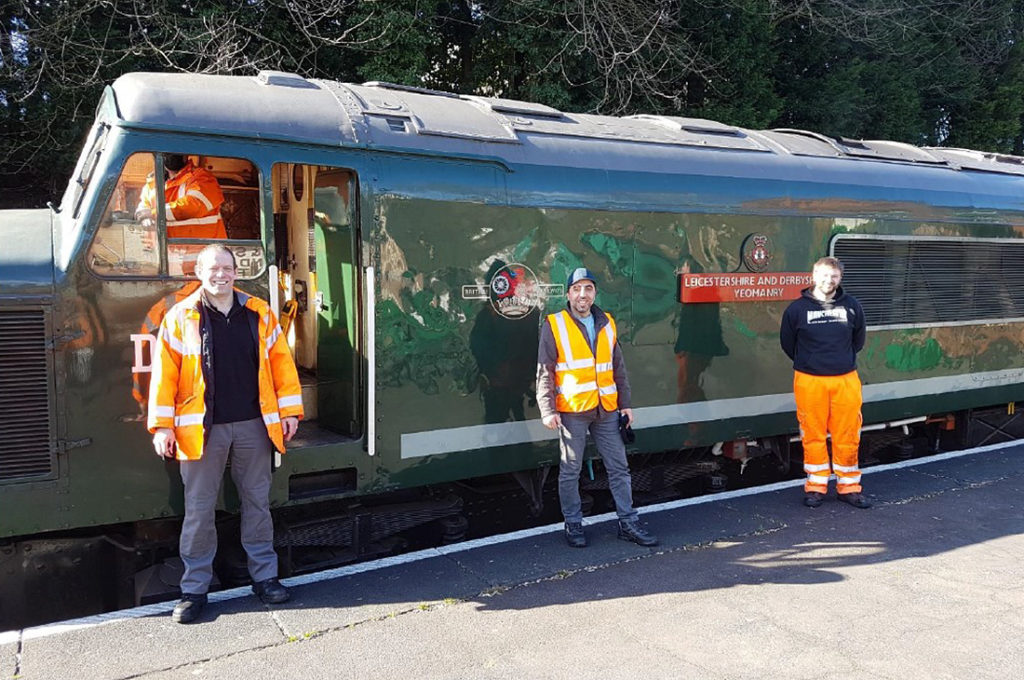In our last edition, we reported some of the highlights of ADHERE 21, work sponsored by RSSB and the industry’s Adhesion Research Group (ARG). There was too much to cover in one article so here is the remainder, focussing on rail head cleaning and dependable speed measurement.
Three presentations were made on progress with developing alternative methods of cleaning rails compared with the current Rail Head Treatment Trains (RHTT) which apply water jets at 1,000-1,500 bar pressure.
Dry ice
Roger Lewis, University of Sheffield, reported on the dry ice project. Briefly, this system fires dry ice pellets at the rail head to clean off leaf contaminant and iron oxide. In autumn 2020, the equipment was installed on the Nexus (Tyne and Wear Metro) RHTT and ran for four days over sections of line notorious for poor rail head conditions. A successful test was also carried out on a Northern Trains Class 155 unit at 40mph in March 2021.
Roger described options for obtaining the dry ice, including delivery, manufacture in the depot and manufacture on the train. The latter needs more development. The RHTT test involved continuous application, but Roger said that future work would explore other options including using a form of machine vision to trigger cleaning based on estimated rail head contamination. He also plans tests at the University of Huddersfield’s Institute of Railway Research (IRR), using its HAROLD test rig at the equivalent of 60mph, and a service trial on a Class 155 unit in autumn 2021.

Plasma Track
Roger Gray of Plasma Track outlined progress with a large Road Rail Vehicle developed by his company which uses a 100kW twin treatment system and was tested in the laboratory to confirm the power-to-speed relationship, demonstrating that an instantaneous surface temperature of >300C can be delivered for leaf removal and >900C for still more aggressive removal.
On-track trials were successfully carried out in autumn 2020. Plasma Track is confident that the system is scalable and proposed two variants for autumn 2021: a 15kW system on a road-to-rail truck for possession use, running at 10kph and delivering a 45mm-wide clean band to replace manual cleaning crews, and a larger 300kW system on a Multi-Purpose Vehicle or RHTT, with most of the equipment in a 20 feet long container. This would be capable of running at 80-100kph and deliver a 45mm-wide clean band. Both systems would be self-contained and use atmospheric-generated nitrogen gas, avoiding the need for compressed nitrogen bottles.


For the future, Plasma Track is planning a passenger train system. This would be miniaturised and optimised to allow predictable braking. For this application, the system might clean a 10mm-wide band aligned with the wheel/rail contact patch. Several of these might be installed along the train.
Passenger and freight train-mounted systems would be active during braking/acceleration, replace sand applicators, require no consumable materials, clean the track for following trains and provide a cumulative effect for the entire network. The system could also be used for wheel tread cleaning.
Water-Trak
John Cooke and Simon Barnard from Water-Trak Limited described progress with their innovation of adding water to help adhesion, something that still feels counter intuitive despite evidence that it works! They explained that wet rails give good adhesion, but damp rails – especially if contaminated – provide very low adhesion. The system has been demonstrated at Long Marson on the Hydroflex train and was fitted to a Northern Trains Class 319, running for over 16,000 miles during autumn 2020, even though the system was only operated over four nights in a Signal Protection Zone between Prescot and Bryn.

The system was triggered by Wheel Slide Protection (WSP) operation. There were three nights of severe contamination and one of moderate contamination. Results for runs between Garswood and Bryn showed significant improvements in both acceleration and braking performance when water was added, noting that the Class 319 with only 25% axles motored has a reputation for struggling to accelerate in poor adhesion conditions. Noticeable improvements to the achieved brake rate for Step 3 demand were observed when using water and the effect was cumulative.
Water-Trak plans to target operators of two and three-car trains for retrofitting with the system. Their trains are not prioritised for the fitment of Double Variable Rate Sanders. John Cooke noted that wetting the rails does seem to improve the performance of the sander systems as more sand sticks to the rail. They aim for an installed price of £30,000 for two systems, one at each end. Each system would have a capacity of 200 litres of chlorinated water from the same source as that used to replenish on-train toilet systems. Water-Trak estimate a payback period of approximately 4-5 years.
Dependable speed measurement
Julian Stow of IRR described the benefits of a dependable speed measurement system. WSP systems typically derive their speed signal from axle-end tachogenerators that measure wheel rotational speed. In the event of wheel slip or slide, the wheel rotation speed remains accurate, but the link to train speed is broken. WSP systems generally take the speed signals from all four axles on a vehicle and use these to estimate train speed, but that speed is probably different for each vehicle in the train.
The ability to control wheel slide depends on the accuracy of and the time taken to establish the estimation. Julian said that simulations carried out using the IRR’s low adhesion braking model, LABRADOR, showed that a reliable, accurate speed signal provided to all WSP systems could reduce a train’s stopping distance by up to 100m when braking from a speed of 20m/s (72kph).

There are other ways of measuring speed including Global Navigation Satellite System (GNSS) radar and accelerometers, though each of these has disadvantages in a railway application. Ideally, speed would be measured in several different ways, but only use the most reliable speed signal for the prevailing conditions.
The automotive industry increasingly uses inertial measurement devices for accurate speed and for stability control/ABS etc, using just such a ‘real time sensor fusion’ approach to speed measurement. The decision on which speed measurement is ‘most trustworthy’ is made using an algorithm known as an ‘extended Kalman filter’ within the sensor itself. To provide the best performance in different applications, a range of motion profiles are available that optimise the Kalman filter.
Speed tracking
IRR undertook tests on an Inertial Navigation System from SBG systems that included a three-axis gyroscope, three-axis accelerometer and three-axis magnetometers, with external inputs for dual GNSS and an external tachometer. Over 45 runs, tests were carried out on a four-mile section of the Great Central Railway at speeds up to 110kph using a Class 45 locomotive. Although the sensor doesn’t currently have a rail-specific motion profile, it was found that good results could be obtained.

Julian presented the interim results, showing a very close fit between the tachometer-derived speed and the estimated speed. The testers induced simulated sudden reductions in wheel speed – the tachometer signal – during braking and monitored how well the estimated speed tracked the true train speed. Even with the sensor using a non-rail motion profile, it was able to accurately estimate the speed for some 25 seconds and, when tachometer variations corresponding to the typical reductions caused by poor adhesion/WSP activity were induced, the estimated speed tracked the actual speed very accurately over the full braking distance from 110kph.
Julian concluded that commercial off-the-shelf inertial sensors show considerable promise in this application. Accurate speed estimation could be obtained on-train during simulated WSP operation, even without using a rail-vehicle-specific motion profile. Application-specific tuning of Kalman filters would further improve accuracy and this would also reduce time taken to initiate/align the inertial sensor. Decisions on which speed signal to trust could also be enhanced considerably with some simple logic. Applications include improving performance of current/legacy WSP systems, providing a speed signal to sanders etc without an interface to train systems and/or providing a reliable speed signal for ETCS.
And finally
Neil Ovenden, chair of the ARG, congratulated everyone on their work and presentations. He also issued a reminder that although these presentations were about improving braking performance, it is still important to clean contaminant from the rails everywhere. Damp, contaminated rails cause poor adhesion, but dry contaminated rails can result in wrong-side track circuit failures and these can cause dangerous occurrences, as illustrated by the RAIB report into the level crossing near miss at Norwich Road in 2019.
Thanks to RSSB and the speakers for their assistance in the preparation of this article.

